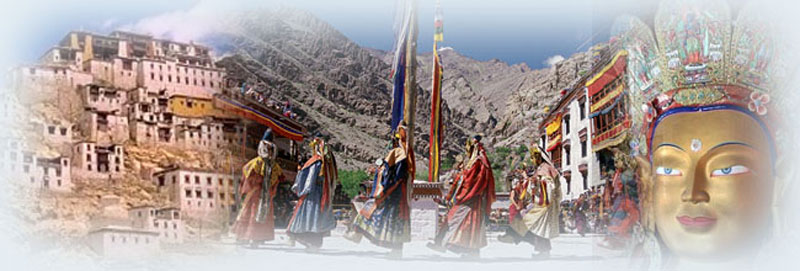
After the Vale of Kashmir the most fascinating & historical part of Jammu &Kashmir is Ladakh.
Ladakh means a land of high passes. It is a region in the Indian state of Jammu and Kashmir between the Kunlun mountain range in the north and the main Great Himalayas to the south, inhabited by people of Indo-Aryan and Tibetan descent.[4] It is one of the most sparsely populated regions in the area. Historically, the region included the Baltistan (Baltiyul) valleys, the Indus Valley, the remote Zangskar, Lahaul and Spiti to the south, Ngari including the Rudok region and Guge in the east, Aksai Chin in the east, and Nubra valleys to the north over Khardung La in the Ladakh mountain range. Contemporary Ladakh borders Tibet to the east, the Lahaul and Spiti to the south, the Vale of Kashmir, Jammu and Baltiyul regions to the west, and the trans–Kunlun territory of East Turkistan in Central Asia on the other side of the Kunlun range across the Karakoram Pass in the far north. Running southwest to northeast, the Altyn Tagh converges with the Kunlun range in Kashmir which runs southeast to northwest forming a “V” shape which converges at Pulu. The geographical divide between Ladakh in the highlands of Kashmir and the Tibetan Plateau commences in the vicinity of Pulu and continues southwards along the intricate maze of ridges situated east of Rudok, wherein are situated Aling Kangri and Mavang Kangri and culminates in the vicinity of Mayum La.
Ladakh is renowned for its remote mountain beauty and culture. It is sometimes called “Little Tibet” as it has been strongly influenced by Tibetan culture. In the past Ladakh gained importance from its strategic location at the crossroads of important trade routes, but since the Chinese authorities closed the borders with Tibet and Central Asia in the 1960s, international trade has dwindled except for tourism. Since 1974 the Indian Government has successfully encouraged tourism in Ladakh.
The largest town in Ladakh is Leh. A majority of Ladakhis are Tibetan Buddhists and the rest are mostly Shia Muslims.
The best time to visit Ladakh is however from June to September every year
Main Monasteries in Ladakh
Alchi Gompa
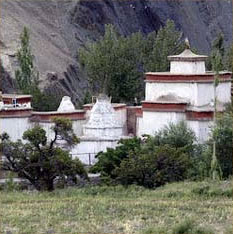
Ladakh at a height of 9,800 feet surrounded by the Himalayas and Karakoram Range houses incredible monasteries in its folds. Located on hillocks or steep mountain tops against the azure skies, it is spectacular to behold this abode of the Divine. With multicolored prayer flags fluttering along the mountain edges, the chilly yet amazingly fresh breeze that blows into to Himalayan Kingdom adds to its beauty. Often you can spot monks in maroon robes silently climbing their ways to the monasteries.
Alchi Gompa of Ladakh at a distance of 67 kms from Leh dates back to the year 1000 A.D. Built by Rinchen Zangpo, it consists of a number of temples including Rinchen Lhakhang at Lotsa Lhakhang.
Alchi Gompa comprises of other temples such as Jamyang Lhakhang (Manjusri temple) and the Sumtsag Lhakhang. There are a number of Buddhists images and statues of their attendants too in the monastery. The main image is that of Vairocana. The paintings in the monastery reflect the Indian style. In his biography Rinchen Zangpo mentioned about the 32 Kashmiri sculptors and woodcarvers who built the Alchi Gompa.
The lofty mountains that circumscribe the Alchi village are enthralling and elate your spirits and ensnare you into using your camera every now and then. The snow clad peaks inspire many a tourist to undertake trekking trips.
Alchi Gompa offers you a glimpse of the importance of Buddhism in Ladakh.
Thiksey Monastery
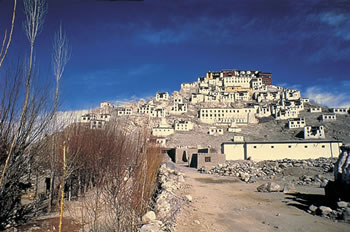
On your tour to Ladakh you will come across numerous monasteries in the Himalayan town. At hilltops casting a panoramic view of the valley below and surrounded by the spectacular snow peaks, monasteries in Ladakh are major tourist attraction. Of all the important monasteries in Ladakh, Thiksey Monastery which is situated at an altitude of 3600 ms above sea level and ranks among the most important monasteries in Ladakh.
Located at 17 km from Leh, the Thiksey Monastery is 12 storeys high. It has many statues of Lord Buddha but the 15m seated Maitreya Buddha in the main prayer hall is spectacular. Besides there is a pillar with the teachings of Lord Buddha and a vast collection of Buddhist art. The monks of the Thiksey Monastery follow the Gelukpa order. Annual festival is held from the 17th to 19th day of the 12th month of the Tibetan Buddhist calendar in the monastery.
Thiksey Monastery is the seat of Tiksey Rinpoche, the main leader of the Gelug School in Ladakh. The 15m high statue of Buddha which was built in1980 is the largest statue of Lord Buddha in Ladakh. It took four years to construct and is made of clay and painted golden in color. The monastery has the sacred Kangyur and Stangyur texts too.
This statue of Buddha in Thiksey is 15 meters tall and was built in 1980. The statue is the largest Buddha figure in Ladakh which took four years to construct and is made of clay and covered with gold paint. The statue houses the sacred Kangyur and Stangyur texts.
Thiksey Monastery offers you a glimpse of the importance of Buddhism in Ladakh.
Lamayuru Monastery
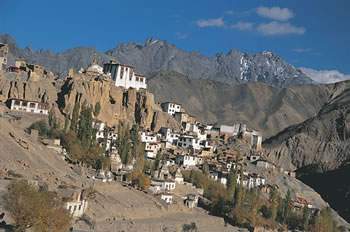
On your tour to Ladakh you will come across numerous monasteries in the Himalayan towns. At hilltops casting a panoramic view of the valley below and surrounded by the spectacular snow peaks, monasteries in Ladakh are major tourist attractions. Situated about 127 kms from the Leh town the Lamayuru Monastery is located on a steep hill between Bodhkharbu and Kha-la-che.
Ladakh, at a height of 9,800 feet and surrounded by the Himalayas and Karakoram Range, houses incredible monasteries in its folds. Located on hillocks or steep mountain tops against the azure skies, it is spectacular to behold these structures. With prayer flags fluttering along the mountain edges, fresh air blows into to Himalayan Kingdom, adding to its beauty. Often you can spot monks in maroon robes, silently climbing their ways to the monasteries.
There are legends associated with the Lamayuru Monastery. Situated in the most scenic locale, it is a hot spot for tourist attractions. The monastery is house to 150 monks and follows the Red-Hat sect of Buddhism.
Lamayuru Monastery is also known as Yung Drung or Swastika monastery. It has many shrines and a rich collection of thangkas and wall paintings. Originally the monastery had five buildings but today there exists only the central building. Annual festivals on the 17th and 18th day of the 5th month of the Tibetan Lunar calendar are held in Lamayuru Monastery where masked dances are performed. Monks from the other monasteries also participate in the celebrations.
Lamayuru Monastery offers you a glimpse of the importance of Buddhism in Ladakh.
Spituk Monastery
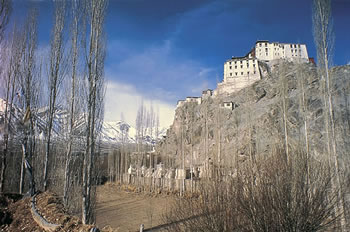
Spituk Gompa of Ladakh dates back to the 11th century. It owes its inception to Od-de, the elder brother of Lha Lama Changchub Od. Od-de led to the establishment of a monastic community at this place. A three-chapel monastery, Spituk is located at a distance of approximately 8 km from the town of Leh. The name “Spituk”, meaning exemplary, has been derived from a statement of a translator, Rinchen Zangpo, about the monastery. He said that an exemplary religious community would develop there, providing the name Spituk for the monastery.
At that point of time, the Spitok Monastery of Leh Ladakh was under the Kadampa School. Slowly and gradually, as time passed, the monastery started functioning under Dharmaraja Takspa Bum – Lde Lama Lhawang Lotus. He brought about the restoration of Spituk and introduced the stainless order of Tsongkhapa (Gelukpa). Even today, the monastery functions under the Gelukpa order only. Three other monasteries of Ladakh, namely Stok, Sankar and Saboo, are considered to be the branches of Spituk Gompa.
The incumbents serving in all these monasteries are the successive reincarnations of Skyabsje Bakula Rinpoche. The main image inside the Spitok Monastery is that of Lord Buddha. Along with that is a sacred image of Amitayus, about a finger high in length. Tsongkhapa, himself, presented this image, to Takspa Bum-Lde. It also boasts of a rich collection of thankas, ancient masks, antique arms, etc. And not to be missed is an impressive image of Mahakaal.
The Dukhang (main temple) also has a high throne at its far end, reserved for the Dalai Lama. The door beside this central throne leads to dark old chapel. The central images inside the chapel are those of Tsong-kha-pa, his two chief disciples and of the Buddha. Spituk Gompa also plays the host to the Gustor Festival, held every year. The festival takes place from the 27th to 29th day in the eleventh month of the Tibetan calendar. A sacred dance also forms a part of the celebrations.
Shey Gompa
Shey Gompa of Ladakh is situated on a hillock, at a distance of approximately 15 km to the south of Leh town. The monastery was erected on the instructions of King Deldon Namgyal, in the memory of his late father, Singay Namgyal. The main image inside the Shey Monastery is that of Buddha Shalyamuni. It is a huge image of the seated Buddha and is considered to be the biggest metal statue and the second largest Buddha statue in the Ladakh region. Copper sheets, gilded with gold, make up this amazing Buddha statue.
The image also contains sacrificial offerings such as grain, jewels, holy signs and mantras inside it. On both the sidewalls of the Buddha statue, are displayed the 16 Arhats (Worthy Ones who have achieved Nirvana), eight being on each side. The back wall of the statue is painted with the images of the two chief disciples of Buddha, namely Sariputra and Maudgalyayana. There is hardly any wall around the Buddha statue that is not painted with any image.
A large bowl of wax with a central flame, symbolizing divinity and purity, is placed in front of the Buddha statue. This flame burns continuously for one year, before getting replaced. Some exquisite murals adorn the second story of the Shey Monastery of Leh Ladakh. While, the lower story comprises of a large library and is decorated with murals depicting Buddha, with various types of hand gestures. An annual festival is also held at Shey Gompa, on the 30th day of the first month of the Tibetan calendar.
Mulbek Gompa
Mulbek Gompa (monastery) dominates the valley. It is easy to see why in bygone times this site served as an outpost to guard the caravan route. Like all Buddhists monasteries it is adorned by frescoes and statues. The last sign of Buddhism, as you shortly head into the Muslim-dominated regions near Kargil and beyond. Mulbekh’s main claim to fame is the impressive eight meter high Chamba statue, an image of a future Buddha, cut into the rock face, dating back to about 700 AD. There are also two gompas serdung and Gandentse, which offer great views of the valley.
Excursions
Situated 45 kms East of Kargil on the road to Leh, Mulbek (3230 m) in an area dominated by the Buddhists. It is situated along either banks of the Wakha River, which originates. Many monuments of the early Buddhists era dot the landscape and are accessible from the road.
The Phugthal complex spills out of the mouth of a huge cave high up in the sheer mountain face of a lateral gorge through which a major tributary of the southern Lungnak (Lingti-Tsarap) River flows. Perhaps, the most isolated monastic establishment of Zanskar, its foundation date back to the early 12th century ; at least one old chappel, among the several several of which it is composed, has frescos and ceiling decorations reflecting strong Indian artistic and iconographic influence. Phugthal is accessible from the Padum-Manali trekking route through a 7 km long trail that branches off from the Purney Bridge on the main trail. A visit to Phugthal, including Bardan and Muney monasteries enrooted, makes a good 5-days round trek from Padum. Alternatively, one can add one extra day to Padum-Manali trekking itinerary to include a day-return visit to this unique monastic establishment inhabited by a resident community of about 40 monks.
Hemis Monastery
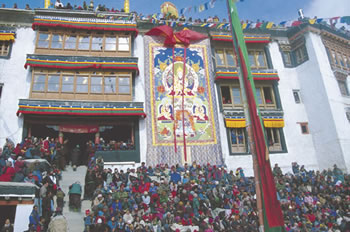
Hemis Monastery holds the distinction of being the biggest as well as the wealthiest monastery of Ladakh. It dates back to the year 1630 and was founded by the first incarnation of Stagsang Raspa Nawang Gyatso. Hemis Monastery is positioned inside a gorge, at a distance of approximately 47 km from Leh. Belonging to the Dugpa Order, it stands on the western bank of the Indus River. The monastery also boasts of a very rich collection of ancient relics.
The array of items kept inside the monastery consist of a copper-gilt statue of the Lord Buddha, various gold and silver stupas, sacred thankas and several other exquisite objects. Situated slightly higher than the Hemis Gompa of Leh Ladakh, is a sacred hermitage, founded by Gyalwa Kotsang. The meditation cave of Gyalwa, along with his footprints and handprints on the rock and sacred shrines, still bring back his memories to life.
The Hemis Monastery also serves as the venue of an annual festival, known as the Hemis Festival. This festival is celebrated as a commemoration of the birth anniversary of Guru Padmasambhav. On the day of the Hemis Festival, the thangka of the monastery is displayed, with a gap of twelve years between successive displays. The Thanka is the sacred appliqué-work tapestry wrought with pearls, which depicts Guru Padmasambhava.
And not to be forgotten is a sacred mask dance that is performed at the monastery every year. The dance takes place on 9th and 10th day of the fifth month of the Tibetan calendar.
Further on request we can chalk out any special itinerary for you, as you wish.

